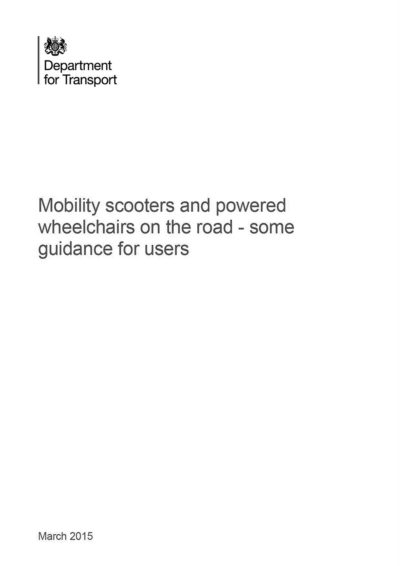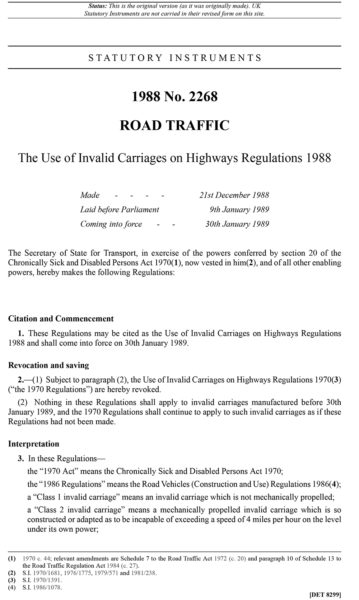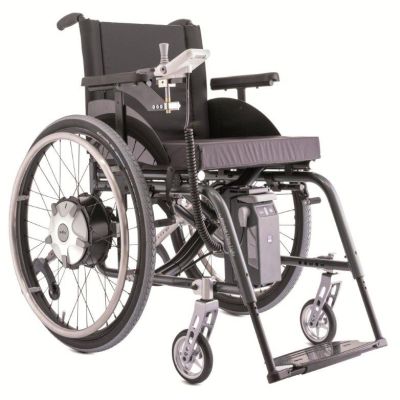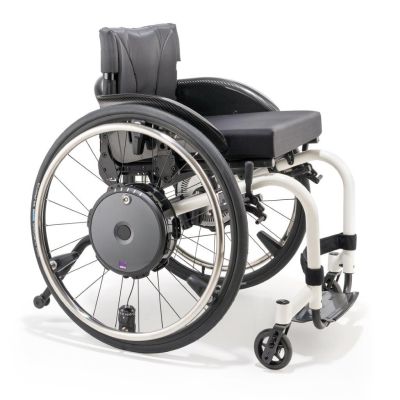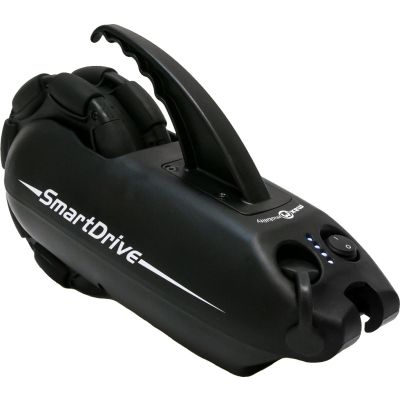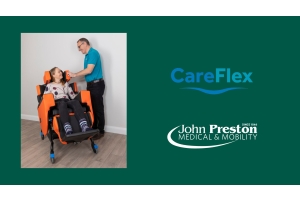Wheelchair power add-ons – What are the highway regulations in the UK?
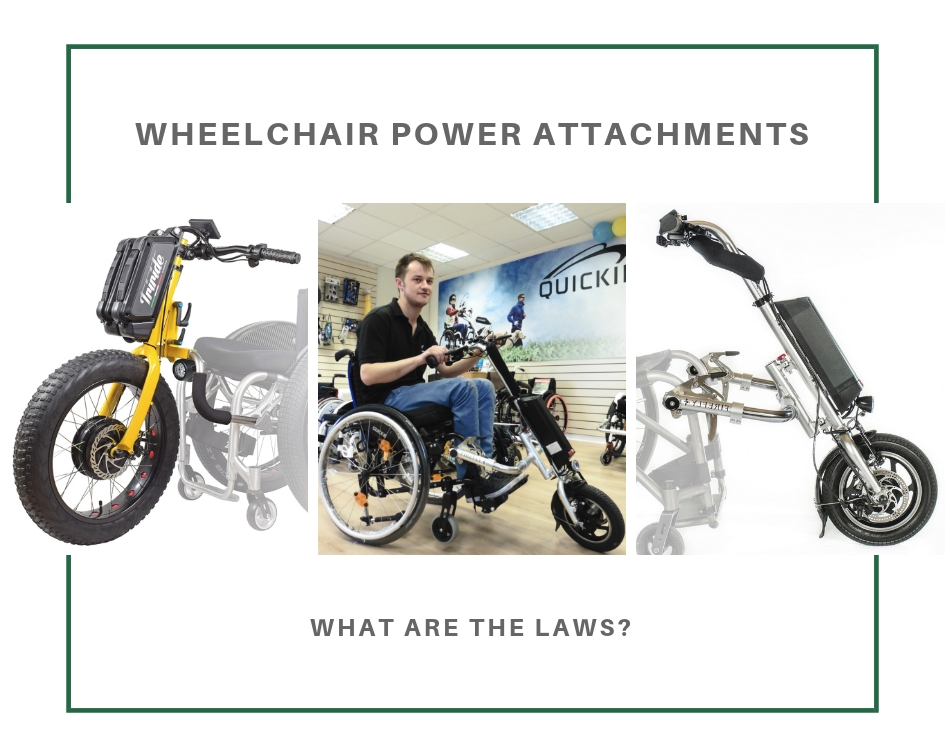
The market for wheelchair powerpacks and power attachments has never been so diverse with new brands and models coming on the market all the time. Wheelchair powerpacks are designed to make pushing manual wheelchairs easier for the occupant or for the attendant pushing the chair. There are many types of powerpacks such as attendant powerpacks that make the attendant pusher’s life easier when pushing up hills, or push assist wheels which boost the occupant ‘s own pushing when going uphill or when required. Front wheel wheelchair powered attachments are also available to clamp to the front of a manual wheelchair providing power assist from the front of the wheelchair.
We frequently get asked about the laws and regulations of using powered add-ons for manual wheelchairs.
To help explain it is probably best to start with an outline of the classifications.
Manual and powered wheelchairs and mobility scooters are medical devices for those who cannot walk or who have difficulty walking. In law you will still find them called 'invalid carriages'. There are three types of 'invalid carriage' defined in 'The Use of Invalid Carriages on Highways Regulations 1988':
- Class 1 - manual wheelchairs, i.e. self-propelled or attendant-propelled, not electrically powered;
- Class 2 - powered wheelchairs and mobility scooters, intended for footpath or pavement use only with a maximum speed limit of 4 mph;
- Class 3 - powered wheelchairs and mobility scooters, for use on the road, with a maximum speed limit of 8 mph but with the facility to travel at 4 mph on a footpath or pavement
The Highway Regulations 1988 state that drivers of class 2 invalid carriages must restrict their speeds to a maximum of 4 MPH when used on pavements / pedestrian zones. Wheelchair Power add-ons including powerpacks and wheelchair attachments which whilst CE marked as Medical devices are in themselves not invalid carriages as they are merely an accessory designed to fit to a class 1 manual wheelchair. Drivers of class 1 manual wheelchairs using power add-ons should adopt the rules for class 2 invalid carriages in terms of maximum speed. In terms of where they can be used, they should follow the rules of both class 1 and 2 invalid carriages meaning they can be used on pavements and in pedestrian zones but cannot be used on the roads except to cross the road or for short distances when the footpath is inaccessible.
Types of wheelchair powerpacks
- Passive Attendant operated push assist powerpacks
This type of wheelchair powerpack is designed to attach to the rear of a wheelchair to assist the attendant or carer pushing the wheelchair. They can be useful when the carer or attendant is frail or if the wheelchair occupant is heavy. They also make it much easier to travel distance as the powerpack does all the hard work. This type of powerpack cannot be operated by the wheelchair occupant. The UK manufactured TGA powerpacks range were the first on the market and still the best quality attendant powerpacks. There are a number of models depending on the weight of the occupant.
- Passive Powerpack - Occupant operated Joystick controlled
This type of powerpack gives your manual wheelchair the benefits of a traditional electric wheelchair with joystick operation but still allows you all the benefits a light manual wheelchair offers in terms of transportability. We supply both the Spinergy ZX1 powerpack which fits to rigid frame chairs and attaches to the camber bar. It can be docked and undocked by pressing a button on the joystick and you retain your original wheels. We also offer the Alber E-Fix E35 power add-on which also adds a joystick to your chair but instead of attaching to the camber bar underneath the wheelchair, the Alber version is built into a pair of wheels that replace your every day wheels.
- Active Powerpack - Occupant operated push assist
This class of powerpack is designed to give the occupant a boost to their own pushing. There are a number of models on the market, some which are built in to the hubs of wheels like the Alber E-Motion M25 & the Handicare Wheeldrive and some which fit underneath the wheelchair like the Permobil SmartDrive. All 3 variants feature a combination of active push assist and passive continuous drive functions meaning that you can set the powerpack to boost your own pushing when struggling up hills or you can set to continuous drive to a custom speed similar to that of a powerchair but without a joystick.
With both options you still have to steer the wheelchair using both pushrims. With these options you can also choose to operate your manual wheelchair without any power assistance.
- Passive Powerpack - Occupant operated Trike attachment
There are a number of wheelchair attachments on the market which attach to the front of the wheelchair and add a powered third wheel to the chair giving it a trike-like performance. This lifts the front castors off the ground and gives better performance over bumpy ground and prevents castors from fouling on cobbled stones, drain grates etc. There are number of variants of power trike attachments available including folding versions which make great travel solutions to large offroad tyre variants capable of going on sand and offroad like the TriRide T-Rocks. One of the most popular models in the UK is the Firefly from Rio Mobility in the USA . Other brands include TriRide, Batec, Quickie Attitude and Alber E-Pilot, Team Hybrid, Stricker, Nino One, and Rehability’s Myskate.
- Active Powerpack – Occupant operated Trike Handcycle attached
Wheelchair handcycle attachments fall into bicycle and E Bike regulations so not wheelchair powerpacks in the typical sense. There is a wide choice of both manual handcycle and power assist hybrid handcycles which like the passive attachments fit to the front of the wheelchair. Unlike the 4 previous categories Handcycles are road legal as they are treated as bicycles. We highly recommend you wear high vis clothing, a safety cycle helmet and a mount a high vis flag on to your wheelchair when cycling on the road. Like with E-bikes, the legislation about motor wattage is on the move and is being increased. All the Hybrid power assist handcycle attachments we sell are legal for use on the roads in the UK.
Wheelchair power attachment laws - FAQ's
Can I use my wheelchair power attachment on public roads?
- Manual wheelchairs fitted with power add-ons are not road legal. The only exception to this rule is when fitting power assist handcycle attachments as these fall under the bicycle regulations.
- All classes of “invalid carriages” can be used on footpaths, pavements, bridleways, and in pedestrian areas at a maximum speed of 4mph.
- However only class 3 scooters and powerchairs can be used on the road.
- Manual wheelchairs fitted with power add-ons are NOT class 3 invalid carriages so can only ever be used on the road if the footpath is blocked or where it is necessary to cross the road.
Do I need to register and insure my wheelchair power attachment?
- No – you do not need to register your power attachment.
- It is not a legal requirement to insure your power attachment however we strongly recommend you do take cover out from a suitable provider such as Fish insurance to cover you in the case of a third party claim or injury.
- Please be aware that most insurance providers will not provide cover for speeds over 8 MPH.
What is the max speed I can go in my wheelchair powered attachment?
- Some wheelchair power attachments are capable of very high speeds of up to 16mph & more.
- There is no speed restriction for manual wheelchairs on public paths and in pedestrian zones, however when using your power attachment it is good practice to limit your speed to a maximum of 4mph (according to Class 2 invalid carriage rules) or less depending on the conditions and how busy it is.
- You may need to reduce your speed to adjust to other pavement users who may not be able to move out of your way quickly enough or where the pavement is too narrow.
- We would recommend that you limit your speed to a maximum of 4 MPH in all public spaces and restrict high speeds to use on privately owned land with the landowners permission. Please be aware that most insurance providers will not provide cover for speeds over 8 MPH.
It is essential you keep yourself and other pedestrians safe.
Further information on rules and regulations of mobility vehicles

